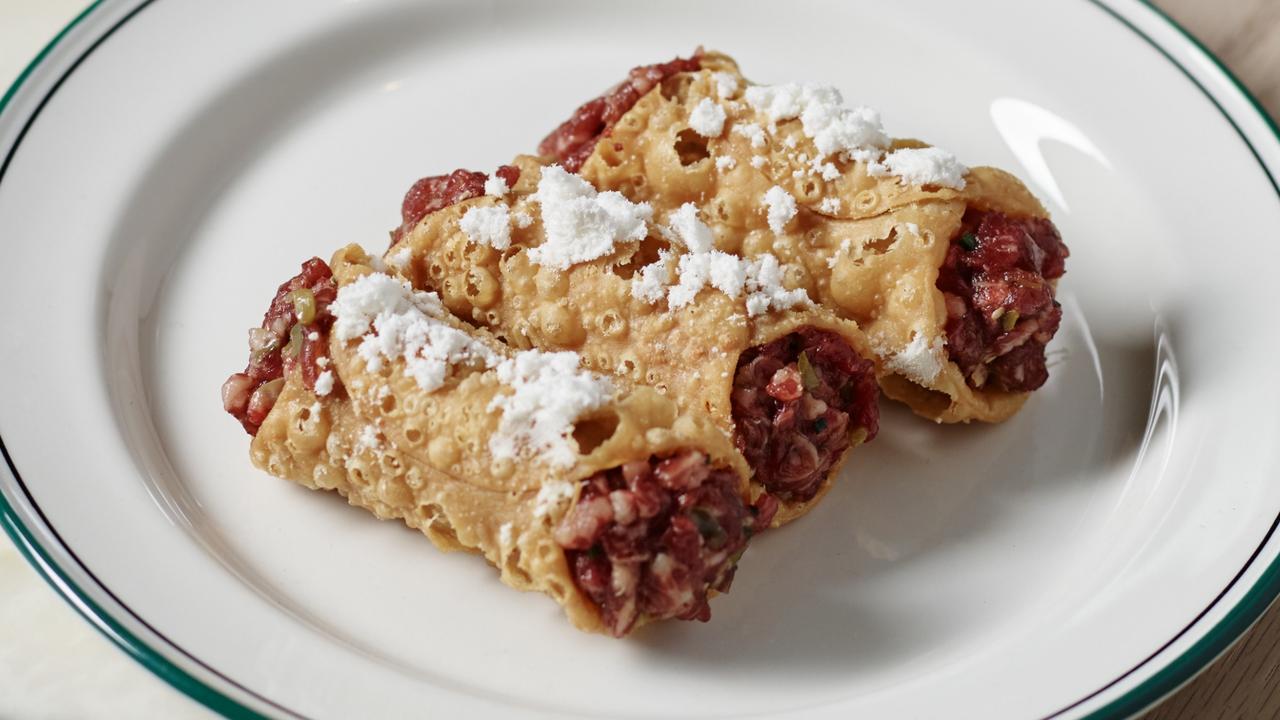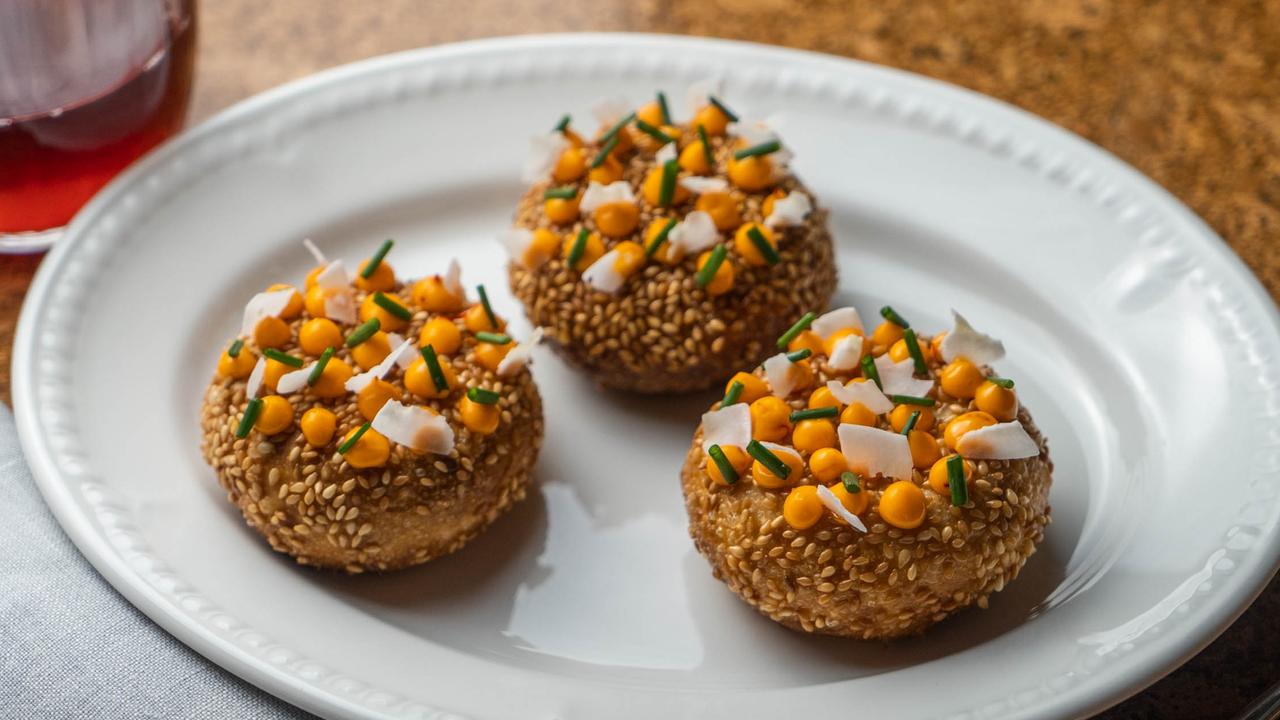Your guide to the many styles of Melbourne’s Japanese restaurants
JAPANESE is the world’s hottest cuisine and Melbourne is serving up some of the best ramen, sushi and sashimi found around the globe. Here’s a guide to where to eat it.

delicious.100
Don't miss out on the headlines from delicious.100. Followed categories will be added to My News.
- Review: Rice Paper Sister
- Winter blues beaters
- Unusual food and wine parings
- Melbourne’s crazy food mashups
HE’S been at the helm of every culinary trend of the past decade or more, whether posh pub or pizza, queuetastic Thai or cool Korean.
In terms of Melbourne’s dining landscape, what Chris Lucas eats, we all end up eating, too.
But it’s taken the restaurateur behind Chin Chin, Kong and Baby more than two decades to come back to one of his first loves – Japanese. Having lived in Tokyo (where his daughter was born), Lucas has come full circle with his newest – and most ambitious - restaurant to date: Kisume.
Named last week as the Hottest Restaurant in the country by The Australian in its annual Hot 50 round up of essential dining experiences, Kisume is a three-level artfully designed space, offering an omakase – or chef’s choice – sushi counter, a full wide-raging menu specialising in local seafood, and is crowned by a 12-seat experience called The Table, where there’s a new Japanese term for serious foodies to get acquainted with: kaiseki.
This multi-course meal that began in the royal courts of Kyoto is the Japanese version of French haute cuisine. “Kaiseki is a creative journey, the ultimate expression of a chef’s craft and the relationship to the land,” Lucas says.
He says opening a restaurant such as Kisume is the culmination of every piece of experience he’s gleaned over the years. “If I had have attempted this 20 years I couldn’t have pulled it off. Japanese food is a refined art, steeped in deep history, and there are so many elements that require acute attention to detail,” he says. “But it’s such a beautifully produce-driven cuisine, it’s transparent, it’s healthy and with increasing interest in the provenance of food – it all comes together right now.”

Pioneered by restaurants the likes of Nobu – which celebrates its 10th anniversary in Melbourne at Crown this week - and Zuma around the world, which serve a contemporary, Westernised version of traditional dishes, Japanese is having its moment in the global culinary spotlight.
“In London, Hong Kong, Japanese is the single hottest cuisine at the moment,” Lucas says. “In New York, sushi and omakase restaurants are opening all the time. It’s the new cuisine, worldwide.”
But it’s not just at the high end we’re seeing this interest in the dining styles of the Land of the Rising Sun. Going out for Japanese these days can mean many different things — from a night of beers and grilled snacks at an izakaya-style bar, to a nourishing bowl of ramen, to a ringside seat at the teppanyaki table.
We’re fast becoming knowledgeable about the tastes and dining styles. Sushi has replaced the salad roll as the office worker’s lunch of choice; business meetings are conducted with chopsticks in hand over tempura and wagyu; and special occasions are spent watching chefs wield sharp knives and work with fire.
Here’s the ultimate guide to the different styles of Japanese dining experiences – and where to dig in.

KNOW YOUR JAPANESE RESTAURANT
SHOKUDO
These are casual, family-friendly diners that offer simple, value-for-money meals such as ramen, tempura, udon, miso soup and bowls of rice. Many will offer a teishoku (set meal) that includes such things as grilled fish, tamago-yaki (Japanese omelet), natto (fermented soy beans) and a small salad.
ORDER: While ramen is a good choice, it’s always a good idea to opt for the bento or teishoku to get a broad taste of what’s on offer.
TRY
Jyu Jyu, 339 Clayton Rd, Clayton
Aka Siro, 106 Cambridge St, Collingwood
Cheeky Chi, 411 Bay St, Brighton
Kappaya, Abbotsford Convent, Helliers St
YAKITORI
Yakitori stalls line the streets approaching most of Japan’s major train stations, giving hurried workers a chance to grab chicken on a stick or kushiyaki (other meats, veg, mushroom or tofu), to eat and go. These skewers are cooked over coal and are usually enjoyed with a cold beer.
Andrew McConnell’s St Kilda restaurant has recently been reborn as Supernormal Canteen, a southside sibling to the always bustling CBD restaurant. At the canteen, he’s installed a yakitori grill in the main bar, where the smoke scents the air like a Tokyo laneway and chefs are grilling skewers of duck hearts, chicken thigh and prawns.
ORDER: Tsukune chicken balls are for beginners — try instead the addictive options of kimo (chicken liver) and kokoro (heart). Can’t decide? Chicken moriawase (mixed platter) offers a spectrum of tastes.
TRY
Supernormal Canteen, 157 Fitzroy St, St Kilda
Yakitori, Box Hill Central

IZAKAYA
Izakaya play the role of a pub in Japanese culture. While it is expected that you’ll order some food, the dishes are simple, affordable and often made for sharing. Of all the types of Japanese diners, it’s the izakaya where you can relax, make new friends
and enjoy true Japanese hospitality.
ORDER: Agedashi dofu (fried tofu in fish broth); wagyu with salt; a mixed kushiyaki moriawase plateof vegetables and tofu; squid prepared on a robata grill.
TRY
Izakaya Den, 114 Russell St, city
Izakaya Chu, 165 Lonsdale St, city
Ichi Ni Nana, 127 Brunswick St, Fitzroy
Izakaya Jiro, 830 Glenferrie Rd, Hawthorn
SUSHI AND KAITENZUSHI
Sushi and kaitenzushi both specialise in sushi, the difference being at a kaitenzushi (conveyor belt sushi diner) the sushi comes to you.
The king of sushi is Kochi Minamishima, and at his eponymous restaurant hidden in a Richmond backstreet you’ll be served a parade of exquisite fish – many of which have been flown in from Tokyo’s Tsukiji fish market – the taste of which is only bettered by watching Kochi’s fingers balletically working perfect rice into the rectangles that are the bed for each piece of fish.
ORDER: A good test of quality is ebi (boiled shrimp) sushi and the tamago (egg omelet) sushi. Both are hard to get right.
TRY
Sushi: Minamishima, 4 Lord St, Richmond
Kenzan, Collins Pl, city
Kaitenzushi: Tetsujin, Emporium, city
Sukura 61 Little Collins St, city

RAMEN
The Japanese take their noodle soups seriously and each region has its own specialty. Ramen is considered a “B-class” (B-kyu gurume) food in Japan — but ramen, along with gyoza, yakisoba and onigiri rice balls, is the soul food of Japan. And here in Melbourne you can get your fix of the restorative broth at any time of day - or night – thanks to the 24-hour Shujinko.
ORDER: Tonkatsu ramen with pork bone soup is a great test of quality. The thicker the soup the better.
TRY
Shujinko, 225 Russell St, city
Hakata Gensuke, Doncaster, Hawthorn city
Ajisen Ramen, various locations
Ramen-ya, Emporium centre, city
Shyun Ramen Bar, 73 Koornang Rd, Carnegie
Fukuryu Ramen, Corrs Lane, city
Mugen Ramen, Bligh Pl, city
TEPPANYAKI
As the name suggests, at a teppanyaki restaurant the chef prepares food, such as highly marbled wagyu beef, Kangaroo Island lobster tail or Atlantic salmon, on a hot teppan griddle, often right in front of you. The idea of cooking meats and seafood on a grill was exported from the West to Japan and now they’re exporting it back.
ORDER: High-grade wagyu steak.
TRY
Koko, Crown Melbourne
Tokyo Teppanyaki, 536 Chapel St, South Yarra
CONTEMPORARY
Contemporary versions of the cuisine take ingredients and techniques and interpret them through an Australian prism of produce and atmosphere. From the tiny Clever Polly’s in North Melbourne, through the three levels of luxe at Kisume, these restaurants provide a very Melbourne experience.
Fusion should not be thought of as un-Japanese — Tokyo has a profusion of fusion, most commonly French. Nobu is the most famous of the fusion restaurants, where chef Nobu Matsuhisa took Peruvian ingredients and added them to traditional dishes, to phenomenal worldwide success.
ORDER: Black cod miso (Nobu), duck with miso consomme (Clever Polly), wagyu beef (Kisume).
TRY
Kisume, 175 Flinders Lane, city
Clever Polly’s, 313 Victoria St, city
Nobu, Crown, Melbourne
Sake, Flinders Lane, Hamer Hall
Heirloom, 131 Bourke St, city
Tokyo Tina, 66A Chapel St, Windsor

GLOSSARY
Binchotan: A dense, smokeless, long-burning charcoal favoured by chefs for its odourless heat.
Dashi: A stock made from fish and seaweed, used as a base in many dishes.
Furikake: A seasoning made from a base of dried fish or vegetables, often sprinkled over rice.
Kaiseki: Japanese haute cuisine made up of multiple courses.
Kakiage: A popular form of tempura.
Matcha: Finely ground green tea powder, found in desserts (and hipster cafes).
Omakase: Literally “I leave it up to you”, it’s a chef’s choice multi-course menu.
Robata: A charcoal grill on which skewers are cooked.
Shiso: A green (or purple) leaf sometimes referred to as Japanese basil.
Togarashi: Also known as shichimi, it’s a spice mix of chilli, pepper, sesame, ginger, nori an poppy seed.
Yuzu: A citrus fruit tasting of a blend of mandarin and grapefruit, used as a seasoning and sweetener.


